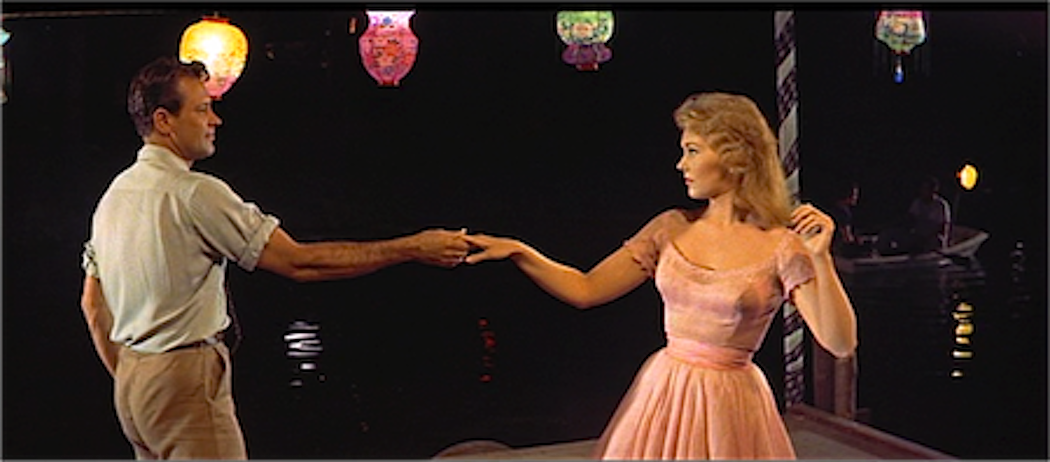MARIANI’S
Virtual
Gourmet
JULY 5,
2015
NEWSLETTER
William Holden and Kim Novak in "Picnic" (1955)
HAVE A GREAT FOURTH OF JULY WEEKEND!
IN THIS ISSUE
AFFORDABLE PARIS RIGHT NOW
By John Mariani
NEW YORK CORNER
THE LEOPARD AT DES ARTISTES
By John Mariani
NOTES FROM THE SPIRITS LOCKER
THE ART OF TEQUILA
By Robert Mariani
❖❖❖
PARIS IS AFFORDABLE
AGAIN FOR AMERICANS!
By John Mariani
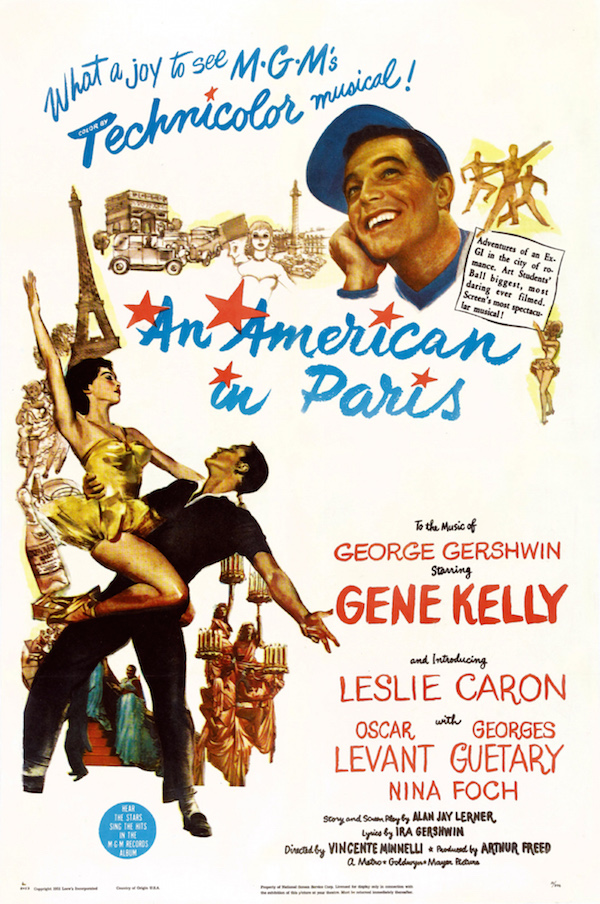
As the song says, “I love Paris in the
springtime. I love Paris in the fall. I love Paris
in the winter when it drizzles. I love Paris in
the summer when it sizzles.”
I suspect most
people do. But
I love Paris most of all when it is affordable,
which it has not been for many years . . . until
now. The
dollar has 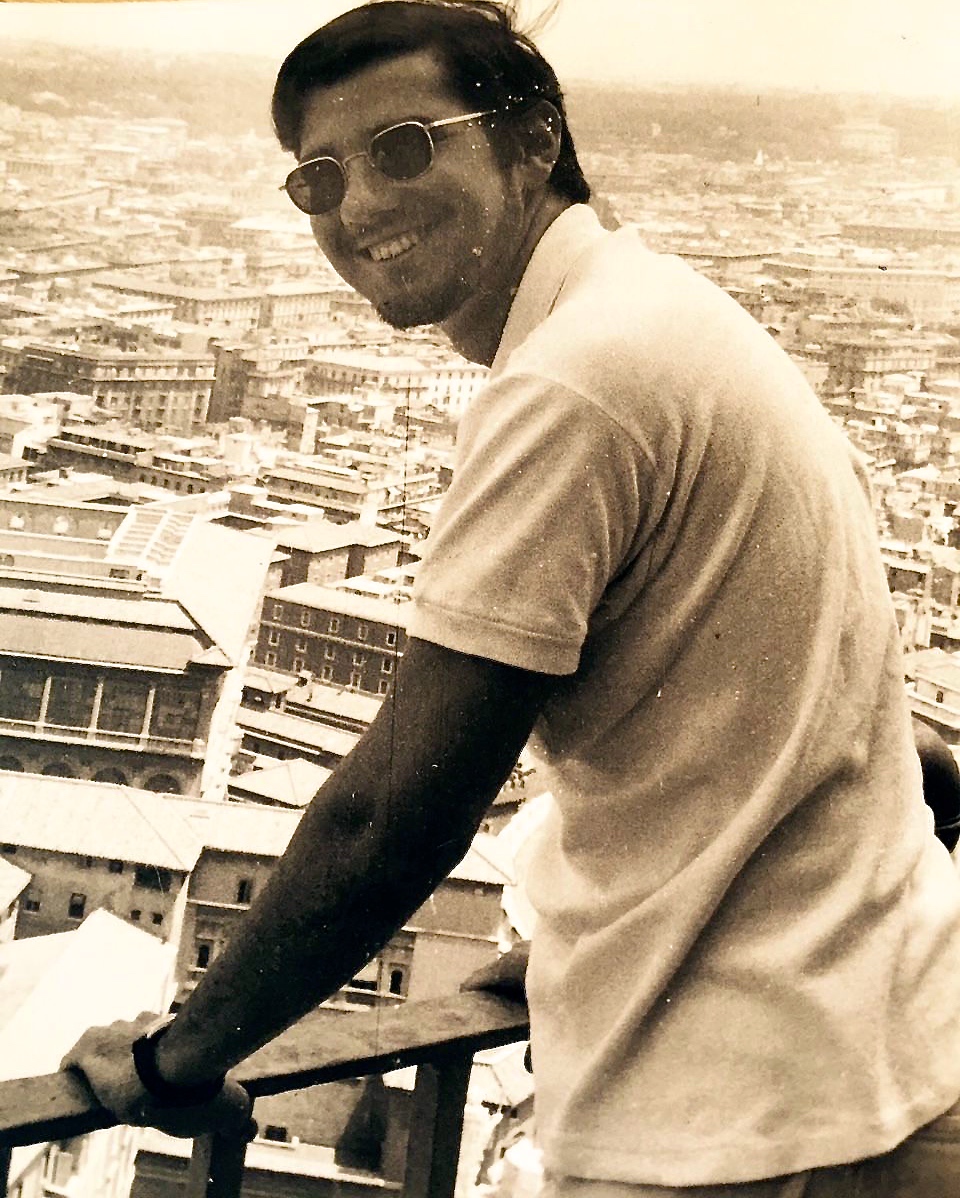 strengthened formidably
against the euro, and, although the latter is back
up to about $1.11 (when I was there
in April, it was $1.05), who knows what the rest of
the year brings, especially if Greece gets the boot
from the EU? Then
all bets are off.
Parity with the dollar is likely.
strengthened formidably
against the euro, and, although the latter is back
up to about $1.11 (when I was there
in April, it was $1.05), who knows what the rest of
the year brings, especially if Greece gets the boot
from the EU? Then
all bets are off.
Parity with the dollar is likely.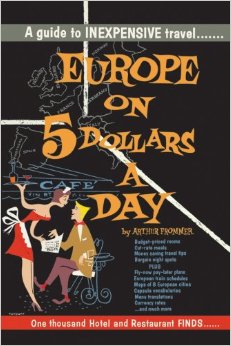
Of course, I’m old enough to
remember when you really could do Europe on $5 a day, even
less if you were willing to stay in youth hostels. I recall
that in the late 1960s I could get a room in Paris
for three bucks, eat steak frites for two
dollars (with a half-carafe of wine, tax and
service), and a summer-long Eurail Pass cost $120. In those
days, by law, all restaurants had to offer an
inexpensive “tourist menu.” That's me, to the
left, on the terrace of my fifth floor walk-up
pension overlooking Paris. T’was bliss to be alive
in those days!
More important, the hotels and
restaurants of Paris have been careful to maintain,
even to trim, prices so as to maximize patronage. In the
past, lunch and dinner prices were usually the same,
but increasingly many of the best bistros are
offering very appealing fixed price menus--which may
be as low as 25 euros and rarely above 39--for a
three-course meal (sometimes with a glass of wine),
tax and service.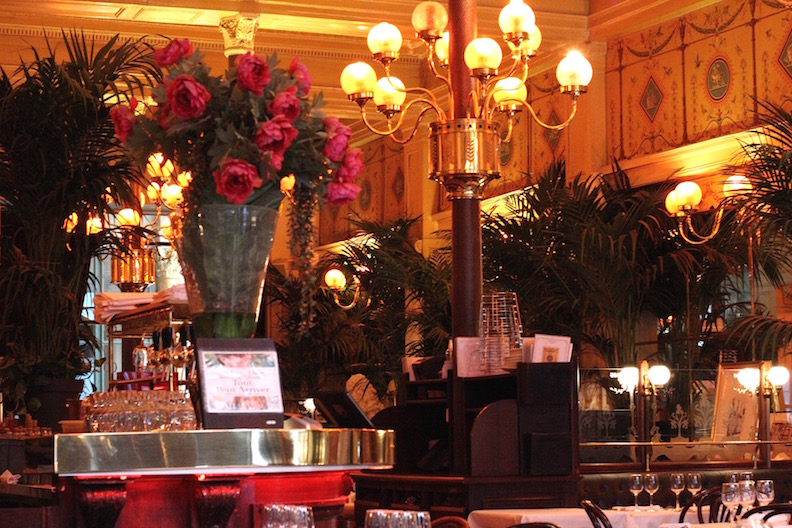
I shall be reporting on where I
ate and stayed in Paris this spring in an upcoming
issue of the Virtual
Gourmet, but for now, let me just note that at
the very popular Le Grand
Colbert (right) three courses are offered
at 37 euros at lunch and after 10:30 p.m. At Guy
Savoy’s delightful Les
Bouquinistes, lunch runs only 36 euros,
with a glass of wine.
Translated (at $1.11 = 1 euro) that works out
to $40. Bargains like this
you do not easily find in NYC, London, Moscow, or
Tokyo.
The best
list of good places with inexpensive meals is the Michelin
Guide’s Bib Gourmand listings for 650 Paris
restaurants (100 new in the 2015 edition) 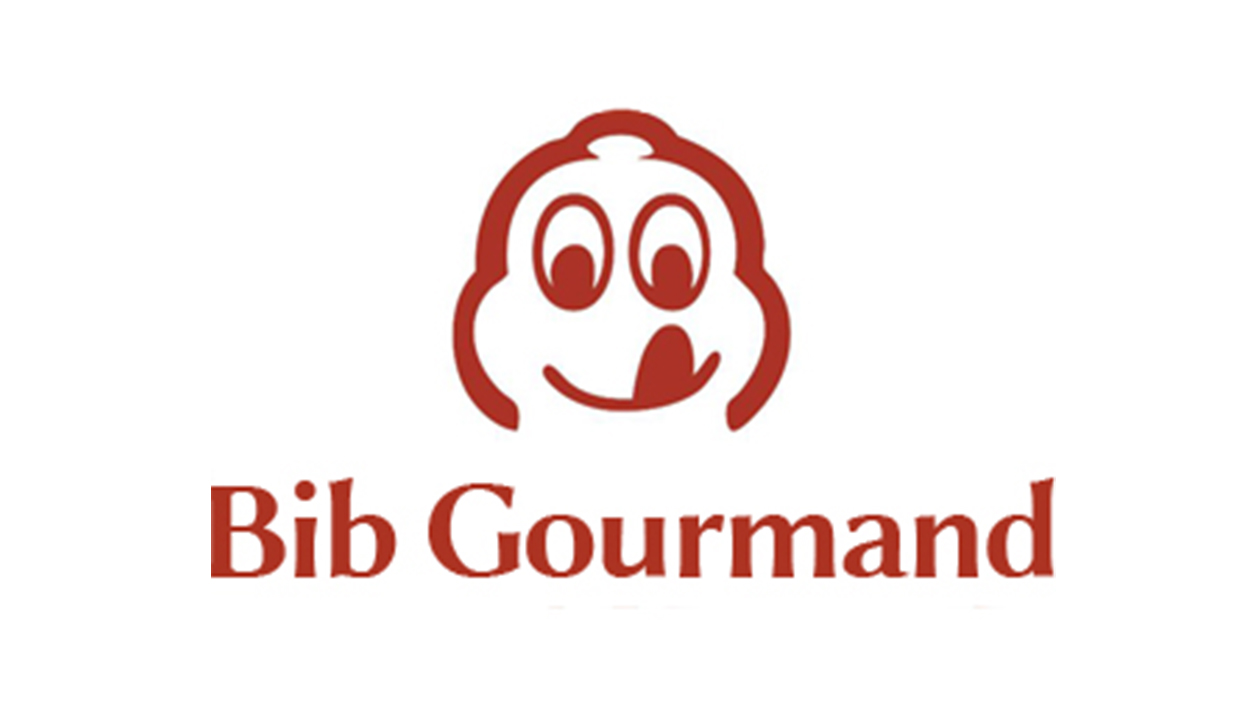 with “cuisine of quality” at a maximum
price of 36 euros. But even some of the top-rated, très cher
deluxe restaurants of Paris now offer good prix fixe
menus. The illustrious Taillevent now offers “Le Menu
Tirel” that includes an apéritif, three-course meal,
half-bottle of wine chosen by sommelier Stephane
Jan, coffee, mineral water, tax and service for an
astonishing 120 euros ($133). Compare
that with NYC’s Jean-Georges at $128 for three
courses--but no
wine, no
coffee, and you have to pay tax on top of that, plus a 20% tip. London’s
Alain Ducasse at The Dorchester will cost you £95
($148), without wine, tax and service.
with “cuisine of quality” at a maximum
price of 36 euros. But even some of the top-rated, très cher
deluxe restaurants of Paris now offer good prix fixe
menus. The illustrious Taillevent now offers “Le Menu
Tirel” that includes an apéritif, three-course meal,
half-bottle of wine chosen by sommelier Stephane
Jan, coffee, mineral water, tax and service for an
astonishing 120 euros ($133). Compare
that with NYC’s Jean-Georges at $128 for three
courses--but no
wine, no
coffee, and you have to pay tax on top of that, plus a 20% tip. London’s
Alain Ducasse at The Dorchester will cost you £95
($148), without wine, tax and service.
Incidentally, although now quite
rare, a few old-time Paris restaurants allow you to
pay for your wine by how much you consumed from a
whole bottle, a nicety called à la ficelle.
These places to eat do not even
include bakeries, crêperies, and charcuteries where
you can make a delightful meal from a sandwich or a
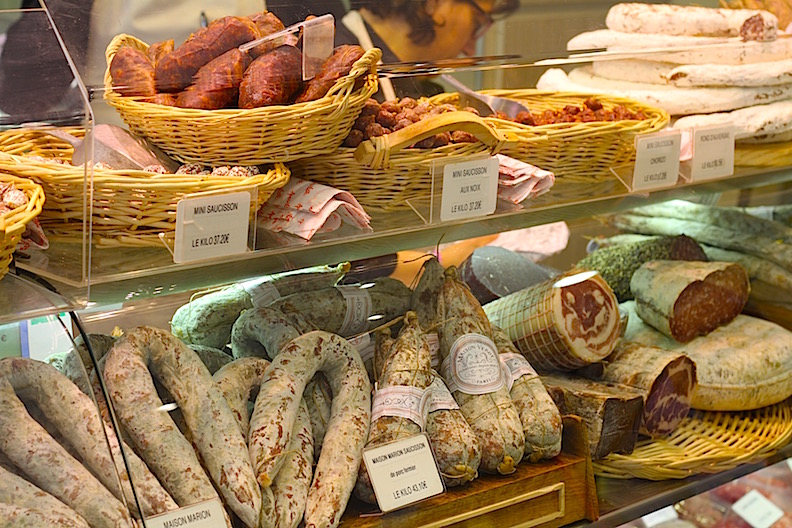 few slabs of terrine. One of
the most famous charcuteries in Paris, Maison Gilles Vérot (right), serves wonderful
take-out items, and at La Maison
Croque Monsieur on Rue Montparnasse
you’ll find the ultimate in French fast food.
few slabs of terrine. One of
the most famous charcuteries in Paris, Maison Gilles Vérot (right), serves wonderful
take-out items, and at La Maison
Croque Monsieur on Rue Montparnasse
you’ll find the ultimate in French fast food.
As for hotels in Paris these
days, the secret is to find a time when the city is not
having a major exhibition or show--fashion, food,
cinema, art, and more. Last year Paris hosted 976
congresses, including the World Gas Conference, the
Antioxidants Conference, Hypnosis Conference, the
Varnish Summit, and Microwave Week. Paris
Fashion Week is held in April and again in
September. The
largest of all is the Paris Air Show, a huge
marketplace for buying private, commercial and
military planes with 2,300 exhibitors from 48
countries, 150,000 professionals, 200,000 public
visitors, and official delegations from 91
countries.
(You can check out the dates for all these
exhibitions at convention.parisinfo.com.)
Finding
a hotel room anywhere in Paris is not only difficult
at those times--and forget about the most deluxe
hotels in the city--but prices will be hiked in
response to demand.
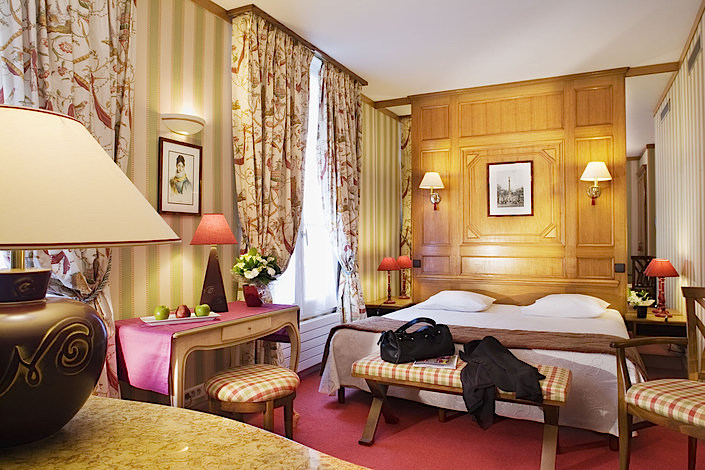 Thus, the best time to
visit Paris and pay a decent price for a good hotel
is when the biggest shows are not on. You know as
well as I the myriad hotel websites available to
book a room, but I must say that Trivago
really does seem to have the best comparison
shopping. And
what I’m seeing on that site for July are very
pleasant hotels (pegged at a distance from the
Eiffel Tower--0.7 miles, 1.9 miles, etc.) for
as low as $77, with plenty of offerings at $100
per night. A
peek at the Hotel Fleurie (left) in St. Germain des Prés
for $124 shows what appears to be sumptuous rooms
with a charming view of the city, half a mile from
city center.
Thus, the best time to
visit Paris and pay a decent price for a good hotel
is when the biggest shows are not on. You know as
well as I the myriad hotel websites available to
book a room, but I must say that Trivago
really does seem to have the best comparison
shopping. And
what I’m seeing on that site for July are very
pleasant hotels (pegged at a distance from the
Eiffel Tower--0.7 miles, 1.9 miles, etc.) for
as low as $77, with plenty of offerings at $100
per night. A
peek at the Hotel Fleurie (left) in St. Germain des Prés
for $124 shows what appears to be sumptuous rooms
with a charming view of the city, half a mile from
city center.
Transportation
within the city is easy enough as long as you don’t
travel by car going to Paris in the morning or
leaving it after work. Otherwise, the traffic is no
worse than many cities and better than in NYC,
London, Rome, or L.A.
You do not
want to take a taxi to the airport, however;
it will be very costly--at least 53 euros--and it
may take forever.
Far easier, less time-consuming and cheaper
is the easy-to-find RER B train
(right) for
10 euros, which takes about 35 minutes to the Gare
du Nord. There
are also two very efficient Air France
buses (if
you avoid rush hours) that go to Charles de Gaulle
and Roissy in about an hour plus. One bus starts out
just across from the Arc de Triomphe.
The Paris Métro,
which in my experience has never been more
dependable, cleaner, and more efficient, is priced
according to how far you travel, so you type in the
destination station, et voilà,
your ticket is priced accordingly. You
save money with a ten-ticket carnet for
13.30 euros.
 And what about tipping? It exists
in Paris, but not in the flagrant way it does when
Americans think they have to tip everyone in sight. Here’s
the deal: In hotels and restaurants a service charge
is built into the bill (as is the VAT tax). So, say
your restaurant check is 100 euros; of that amount,
10 euros will be for the VAT, and 12 for service. The
latter does not
go to the waitstaff at the end of the night because
they are paid a set wage. Therefore, you need not tip
anything at all, although leaving a few small coins
at a café (called a pour-boire,
“for a drink”) or rounding off the bill for a taxi
is customary.
If, however, you have that 100 euro tab with
the service built in, leaving more than a few euros
is either showing off or being insecure. The
waitstaff will not hate you if you don’t tip; they
will of course appreciate it if you do.
And what about tipping? It exists
in Paris, but not in the flagrant way it does when
Americans think they have to tip everyone in sight. Here’s
the deal: In hotels and restaurants a service charge
is built into the bill (as is the VAT tax). So, say
your restaurant check is 100 euros; of that amount,
10 euros will be for the VAT, and 12 for service. The
latter does not
go to the waitstaff at the end of the night because
they are paid a set wage. Therefore, you need not tip
anything at all, although leaving a few small coins
at a café (called a pour-boire,
“for a drink”) or rounding off the bill for a taxi
is customary.
If, however, you have that 100 euro tab with
the service built in, leaving more than a few euros
is either showing off or being insecure. The
waitstaff will not hate you if you don’t tip; they
will of course appreciate it if you do.
In hotels it is the same. Invariably
guests tip the fellow who delivers their baggage,
but no more than a euro per bag. Your
hotel room already includes a 20% VAT and a
service charge, so the people who clean your room
are being paid a set wage. If you choose to leave a tip
for them, you’re being kind, but it is not expected.
As for the
concierge, he is well paid to perform all sorts of
services, including the most difficult to obtain. 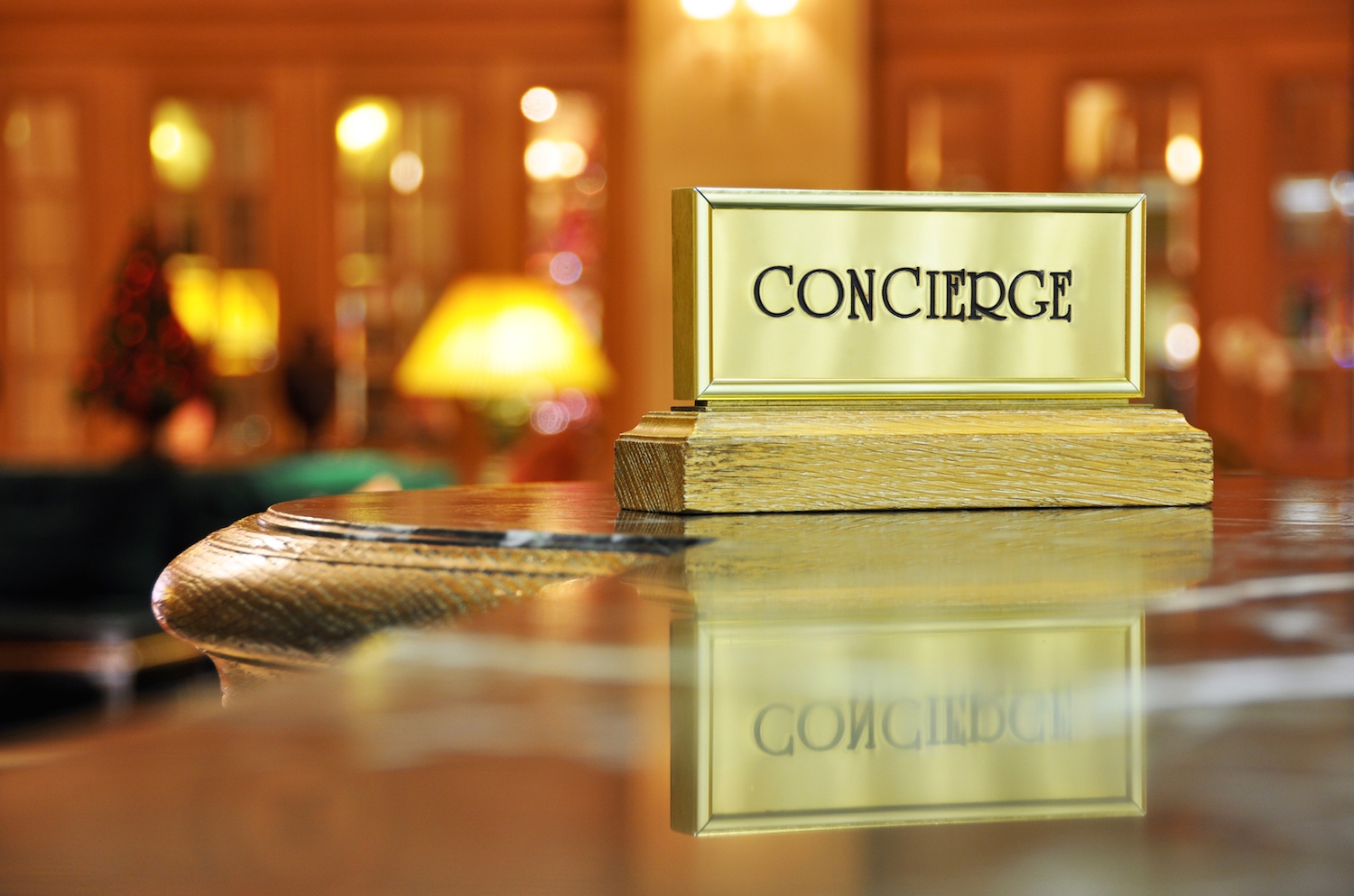 So, if he
arranges for a table for an impossible-to-get-into
restaurant or arranges for a private tour of the
Louvre after hours, he should get a nice tip. But, if
all he’s done is make a reservation, show you the
route to Les Halles, or recommend a good shoe shop,
there’s no reason to.
That's his job. It is, however, a
smart idea to tip a concierge when you expect to be
a regular at the hotel in the future. A
ten-euro tip may not make you a V.I.P. (at least not
at a time when Russian billionaires tip
exorbitantly), but he probably will have it in your
record for the future.
So, if he
arranges for a table for an impossible-to-get-into
restaurant or arranges for a private tour of the
Louvre after hours, he should get a nice tip. But, if
all he’s done is make a reservation, show you the
route to Les Halles, or recommend a good shoe shop,
there’s no reason to.
That's his job. It is, however, a
smart idea to tip a concierge when you expect to be
a regular at the hotel in the future. A
ten-euro tip may not make you a V.I.P. (at least not
at a time when Russian billionaires tip
exorbitantly), but he probably will have it in your
record for the future.
Of nothing is there more nonsense
written by travel experts--especially editors of
high-end American travel magazines who should know
better--than about tipping in various countries,
including France.
When in doubt, ask a Parisian. The
American magazines--though not the British--say you
should tip everyone, but that’s utter twaddle.
A Few Other Notes:
• It used to be better to get your euros from an ATM
machine and to use credit cards instead of cash, but
these days, in addition to the ATM service charge,
you may find that when you get home you also pay a
foreign transaction fee on your credit or bank card.
That includes charges for hotels, restaurants and
other payments.
I still use the ATM, but only with a bank
credit card that does not charge
such a foreign transaction fee. And to
avoid further service charges from the ATM, I
try to take out enough euros one time only to last
me through my stay.
 • The
VAT refund on merchandise you bought can be a pain
in the neck to file for when you get to the airport,
and the refund is never as much as you thought it
would be, but it’s still a 20% tax that you, as a
foreigner, need not pay. To make things a little
easier, remember to carry your passport if you go
shopping. Ask
the merchant to fill out the “tax-free form” for you and attach
your receipt.
Some stores, which usually have a “Tax Free”
sticker in their window, will offer to mail in your
forms and give you a tax credit on your credit card,
though they may charge a fee.
• The
VAT refund on merchandise you bought can be a pain
in the neck to file for when you get to the airport,
and the refund is never as much as you thought it
would be, but it’s still a 20% tax that you, as a
foreigner, need not pay. To make things a little
easier, remember to carry your passport if you go
shopping. Ask
the merchant to fill out the “tax-free form” for you and attach
your receipt.
Some stores, which usually have a “Tax Free”
sticker in their window, will offer to mail in your
forms and give you a tax credit on your credit card,
though they may charge a fee.
• Take your purchases with you. Unless
it’s a piece of furniture, don’t ask them to ship it
because costs will be outrageously high.
• B.Y.O.B. is not done in Paris, but, if you do,
shame on you--and expect a whopping corkage charge.
• Parisians obviously take their culinary reputation
very seriously, and it is applied even to the
cafeterias and restaurants in their museums, which
offer some very good value for delicious food. The Musée d’Orsay
has three—Restaurant,
with 22 euro and 32 euro meals;  Café de l'Ours
for salads, sandwiches and pastries (right); and Café Campana
for brasserie fare.
Café de l'Ours
for salads, sandwiches and pastries (right); and Café Campana
for brasserie fare.
• Always ask
about Wi-Fi charges! Even today, when hotels have
gotten very competitive about offering the service
for free, many deluxe hotels in Paris do not, and
you may wind up paying a 25 euro charge for less
than a day’s coverage. Paris itself is well wired, so
there are plenty of hot zones outside the hotels.
• Breakfast is often included in hotel room prices,
but make sure you ask. If not, it is much better to
go around the corner to a pastry/bakery shop or café
and have a fresh croissant and coffee for a few
euros.
• Of course, as everyone knows, you’d be a complete
fool to take anything out of the minibars. But, if
you do, here’s a hint: Owing to the way minibars are
checked (not every day), you may dispute that charge
for a Toblerone bar and I guarantee the cashier at
the front desk will take it right off your bill, no
questions asked.
Don’t try that with the pillows or towels,
though.
❖❖❖
By John Mariani
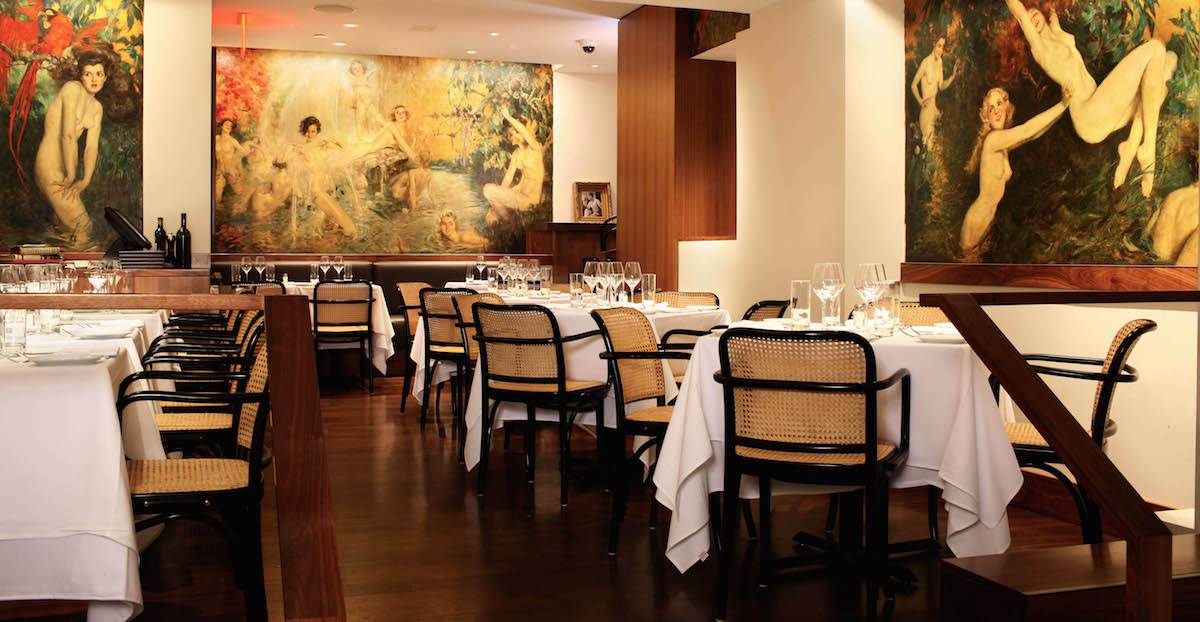 The Leopard
at des Artistes
The Leopard
at des Artistes1 W 67th Street (near Central Park West)
212-787-8767
The
rich cultural and gastronomic history of the
dining room space within the Gothic-Tudor-style
Hôtel des Artistes (actually a residence), began
when it was first an artists' studio, then
continued as the Café des Artistes, on whose walls
Howard Chandler Christy painted his 1930s murals
of 36 naked young women romping in woods that look
a lot like Central Park.
Risqué in their time, they look
every bit as risqué in ours, and while their
continuing precence in the dining space has never
been secure, they are still there. The happily
naked girls--who look like New York debutantes, or
models for the artist’s more demure “Christy Girl”
magazine covers--swing on vines, dance
rapturously, and shower under a waterfall, all
managing to look both shyly innocent and
tantalizingly seductive at the same time, as if we
onlookers are Peeping Toms. The murals are as
inseparable from the city's popular culture as the
New York Public Library lions or Maxfield
Parrish's "Old King Cole" mural at the King Cole
Bar in the St. Régis Hotel.
For decades the Café des
Artistes was a favorite hang-out for artists,
actors, opera stars and musicians--Lincoln Center
is a block away--but, when the lease ran out six
years ago, it seemed time had run out on the space
as a restaurant.
Fortunately, veteran restaurateurs
Gianfranco and Paula Sorrentino, who also own Il
Gattopardo and Mozzarella
& Vino across from the MOMA, turned the
space into The Leopard at des Artistes four years
ago, and it has again assumed its rightful place
as a classic New York dining venue. Not to
dine here upon visiting NYC is like missing tea at
the Palm Court at the Plaza or not having a drink
at the bar at `21’ Club.
The dining room is as lovely as
ever, though when I dined there last month the
lights had been lowered and the murals showed less
of their vivacity in the dimness. (I’ve been told
that this is being or has been remedied since
then.)
The Sorrentinos are usually at one or the
other of their restaurants each day, and maître d’
Alessandro Giardiello adds a European amiability
to the evening’s proceedings.
 The
wine list is excellent, especially with Italian
small estate bottlings, and the wines by the glass
($12-$29) judiciously chosen. The white selections
are particularly interesting with rarely seen
wines like Poggio dei Gorlei Pigato “Albium” 2010
and Trebbiano D’Abruzzo “Altare” Marramiero 2010. By the
way, on Sunday evenings the restaurant has a”BYOB
Sunday Supper,” with no corkage fees.
The
wine list is excellent, especially with Italian
small estate bottlings, and the wines by the glass
($12-$29) judiciously chosen. The white selections
are particularly interesting with rarely seen
wines like Poggio dei Gorlei Pigato “Albium” 2010
and Trebbiano D’Abruzzo “Altare” Marramiero 2010. By the
way, on Sunday evenings the restaurant has a”BYOB
Sunday Supper,” with no corkage fees.
There is a fine
new executive chef aboard, Michele Brogioni (left), with
20 years experience that includes winning a
Michelin star while at Il Falconiere in Cortona,
Italy, and his cooking shows more finesse than the
menus here previously had. Every
dish is carefully composed from the finest
ingredients, and there is a delicate balance of
sweet, sour, salty and bitter impeccable
throughout (throw in some umami, if you like),
whether it’s combining housemade friselle
with Swiss chard, anchovies and tomato ($14) or tortelloni (below) filled
with three meats and prosciutto and dressed with a
veal sauce, mascarpone
and thyme ($24).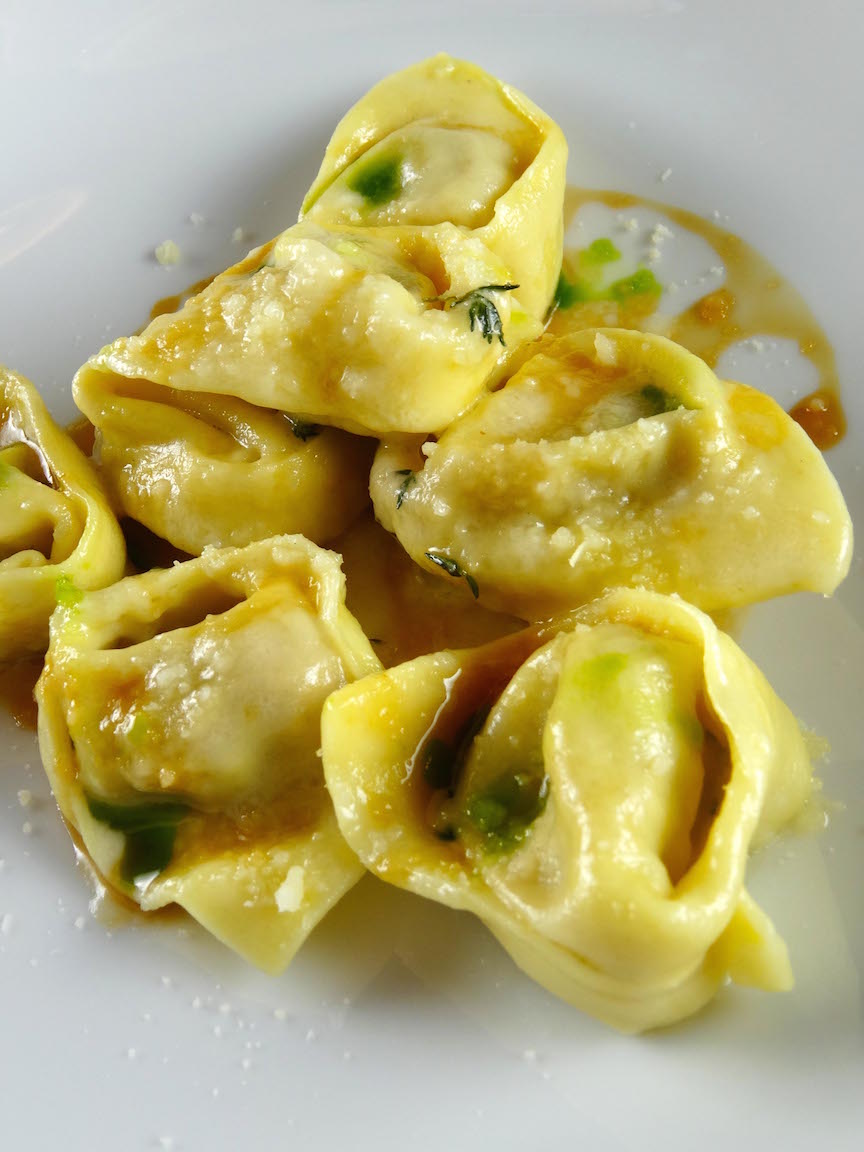
Many Italian restaurants these days offer a
cutting board of charcuterie and cheeses, though
they are not always top-notch examples. Brogioni
chooses wisely and serves them with fruits,
mustard fruits and a rustic Neapolitan spiced
bread called casatiello
($25).
His pastas easily rank with the best in the
city, not because they are novelties but because
they are all based on the Italian rule of
simplicity, heightened with refinement and beauty. The gnudi (below) of
buffalo milk gnocchi come
bathed in nothing more than butter and Parmigano
atop organic spinach ($16), and they will make you
swoon. The
spaghetti alla
chitarra comes with a rich rabbit ragôut,
Taggiasca olives and wild arugula ($24), and
escarole-stuffed ravioli of wondrous delicacy are
dressed with pine nuts, raisins, Gaeta olives and
a Genovese-style sauce ($19). There is a risotto
special each night, and our table lapped up the
version with woodsy funghi
porcini ($24).
Again, main courses are kept simple in
order to manifest the prime ingredient’s own
flavor, so that red snapper is quickly pan-seared
then scented with fennel, capers, and a tangy
lemon sauce ($37). Equally as delicious is the
veal chop alla
milanese with arugula, oven-dried cherry
tomatoes and pickled onions ($48), a variation of
the usually quite plain pounded, breaded veal
chop; here the sweet and sour flavors of the
tomatoes and onions add measurably to the dish.
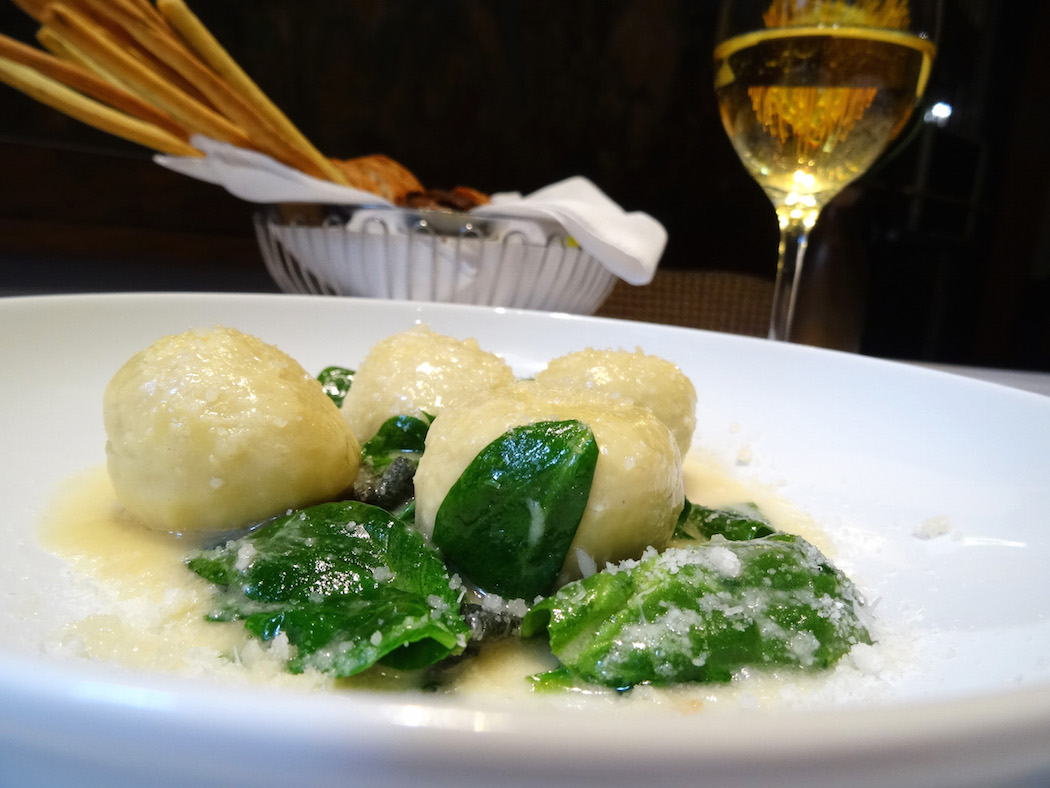 A
delightful Sicilian item is the seasoned, breaded
pork on skewers ($38), an excellent choice for
summer--they should sell them out on the sidewalk! Pan-seared
duck breast is done “in porchetta”
style, that is as a roulade, with aromatic of wild
fennel, sour onions and potato frittata
($39). It
was a good dish but lacked the heft of flavor of
the other dishes.
A
delightful Sicilian item is the seasoned, breaded
pork on skewers ($38), an excellent choice for
summer--they should sell them out on the sidewalk! Pan-seared
duck breast is done “in porchetta”
style, that is as a roulade, with aromatic of wild
fennel, sour onions and potato frittata
($39). It
was a good dish but lacked the heft of flavor of
the other dishes.
It is no longer accurate to say Italian
restaurants neglect desserts--though most offer
disappointing clichés--and The Leopard proves its
kitchen is as serious in that department as in
what precedes them.
What a joy to crunch into a just-made
cannoli (below)
of creamy sheep’s milk ricotta and chocolate chips
($12); a classic babà soaked with rum and topped
with whipped cream and summer berries ($12);
almond semi-freddo
with apricot sorbet and plum sauce ($12); and a
rich lemon-verbena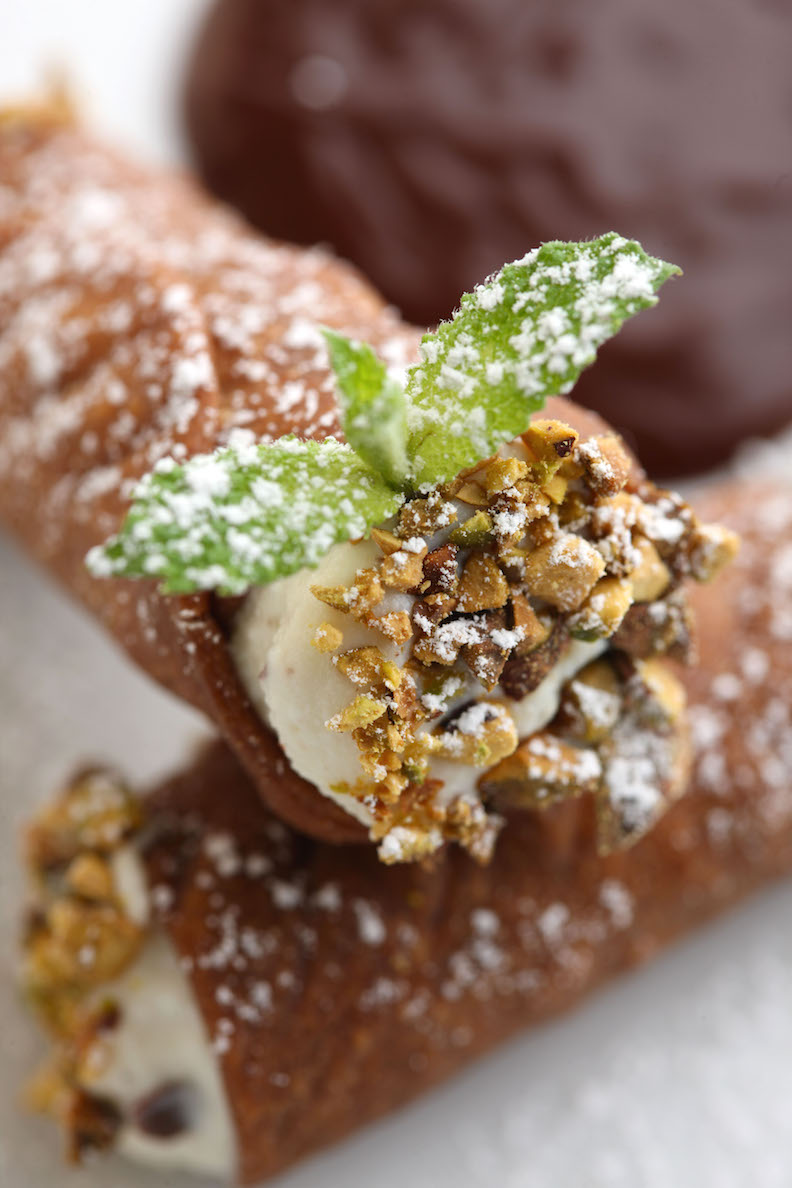 panna cotta
with blueberry compote ($12).
panna cotta
with blueberry compote ($12).
As at the
Sorrentinos’ other ristorante,
Il Gattopardo (which means "the leopard” in
Italian, named after the great Sicilian novel by
Giuseppe di Lampedusa), The Leopard at des
Artistes embodies la finezza,
which takes a long time to develop and a longer
time for a chef to leave his personal stamp on
without betraying tradition. Like
those not-so-innocent girls in the murals, there’s
a secret story behind every dish at The Leopard
that reveals itself in every morsel.
The Leopard at Des Artistes is open
for dinner nightly and brunch Sat. & Sun.
There is a pre- and post-theater fixed price
three-course dinner at $35.
❖❖❖
 BEAUTY
IN A BOTTLE--
BEAUTY
IN A BOTTLE--THE TEQUILA MYSTIQUE
By Rob Mariani
Did
you know that a bottle of fine, well-aged tequila
can cost as much as $1,800 or more? That’s not
just because this traditional Mexican beverage
continues to evolve and become more popular with
connoisseurs. It’s also because this many-faceted
drink is presented and sold in some of the world’s
most creatively designed bottles.
Once you see the exquisite
artistry that goes into the making of these glass
and ceramic masterpieces, you’ll realize they are
worth every penny, and why they are so coveted by
collectors the world over. Take for example a
bottle of Milagro
Romance Extra Añejo (right).
The crystal-clear, hand-blown bottle has
three inner chambers that are craftily suspended
inside the unique outer bottle. Each chamber is
filled with 100% Blue Agave Select Barrel Reserve
anejo
tequila, and each represents a year of the
tequila’s aging to maturity. 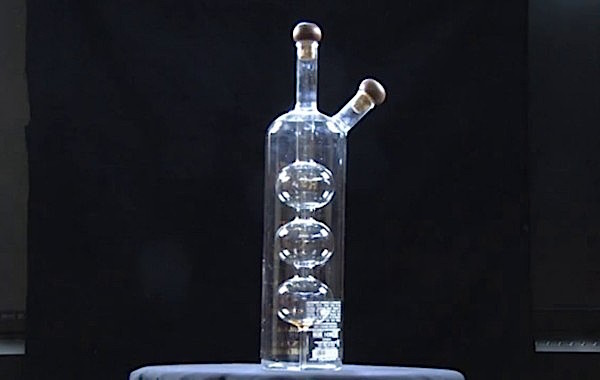
Some bottles depict ancient
myths and gods, while others feature more abstract
arrangements or recaps of Mexican folk tales. One
of the artisanal tequilas comes in a hand-crafted,
ceramic bull’s head that is ringed by six shot
glasses with miniature bull’s heads wrapped around
each glass.
A Gran
Centenario Azul Gran Reserva is one of the
most beautiful bottles of tequila to come
from Mexico.
Both the bottle and the tequila are
extremely rare. The bottle’s elegant blue ceramic
body depicts a bronze angel playing a long trumpet
in its hollowed out center. The bottle comes
cradled in a handcrafted burlap “display case”
along with a booklet of information about the
specific brand of tequila.
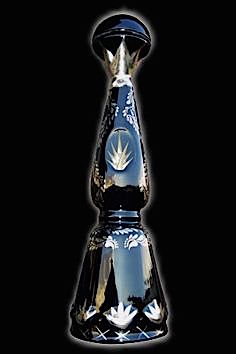 And the
dazzling creativity doesn’t end with just
beautiful bottle designs. Many of the fine tequila
bottles come in meticulously hand-made wooden
boxes adorned with original graphics--art work
that makes these boxes collectors' items as well.
And the
dazzling creativity doesn’t end with just
beautiful bottle designs. Many of the fine tequila
bottles come in meticulously hand-made wooden
boxes adorned with original graphics--art work
that makes these boxes collectors' items as well.
A GUIDED TASTING TOUR OF
TEQUILA-INSPIRED CUISINE
There are so many
aspects to this unique art form of making fine
tequila and packaging it in extremely imaginative
ways, that there is now a newly opened “Tequila
Art Museum” in Providence, Rhode Island’s capital
city. In addition to the dozens of original
tequila bottles on display in this small but
well-focused venue, the museum also offers
two-hour evening tasting tours twice a week, 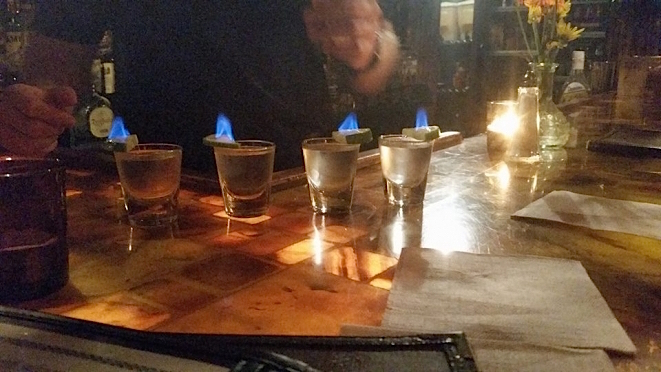 Monday and
Thursday in Providence’s much lauded dining
district, known as Federal Hill. Each tour
features a tequila and food pairing at three of
Federal Hill’s most acclaimed restaurants, as well
as a guided tour of some of the other culinary
highlights in this historic area.
Monday and
Thursday in Providence’s much lauded dining
district, known as Federal Hill. Each tour
features a tequila and food pairing at three of
Federal Hill’s most acclaimed restaurants, as well
as a guided tour of some of the other culinary
highlights in this historic area.
All tastings
are included in your ticket
purchase. Enough food is served that, for
most participants, a meal afterwards is not
needed. $40 tickets can be purchased at TequilaArt FedHill (right).
 THE WORLD SHOWERS CHARLESTON WITH
AMAZING GRACE--AUCTION FOR COMMUNITY UNITED
CHARLESTON INCLUDES ONCE-IN-A-LIFETIME
LUXURIES
THE WORLD SHOWERS CHARLESTON WITH
AMAZING GRACE--AUCTION FOR COMMUNITY UNITED
CHARLESTON INCLUDES ONCE-IN-A-LIFETIME
LUXURIES
CHARLESTON, SC – Organizers of
the Community
United Charleston fund and event have
been showered with auction items best described as
extraordinary. The Fund sprang up hours after nine
individuals were shot in the historic Mother
Emanuel AME church. Auction bidders – who
can pre-register and participate from anywhere at
www.bidr.co/communityunited
– are invited to bid on hundreds of auction items
ranging in value from $50,0000 to $50. The auction
opens at noon on Friday, July 3 and closes at
midnight Thursday, July 9. Bidders need not be
present to participate. Among the rare items –
which are included in the complete gallery at
https://bidr.co/events/items.php?evt=3000:
·
A City and Safari package with
round-trip Business Class tickets to Capetown,
South Africa featuring stays at the Belmond Mount
Nelson Hotel and a Belmond safari reserve.
·
More
than 100 pieces of original art, valued from $500
to $15,000.
·
A
weekend for two in New York City, including
all-access tickets to the New York Wine
Experience, plus business class air tickets.
·
Tickets
to the Food & Wine Classic in Aspen, an event
that typically sells out.
·
A
ticket package including access to the Grammy
Awards.
·
A
Brazilian Bucket List Trip from Belmond, offering
nine nights at the iconic Belmond Copacabana Place
and Belmond Hotel das Catartas in Iguazu National
Park (named one of the seven wonders of the
world).
·
75
hotel stays in the United States and abroad.
·
52
weeks of dining out in Charleston’s world-class
restaurants.
·
A
Tuscan Grand Tour featuring round trip business
class airfares plus eight nights in the Italian
wine region, including a 3-night stay at Belmond
Hotel Splendido.
Organizers place the total value of auction items collected thus far to be in excess of $500,000.
❖❖❖
AND HOW ABOUT A BIB AND DIAPERS FOR THAT?

Zéro de Conduite, a Parisian bar, is serving cocktails from baby bottles. One Yelp reader reported, “Yes, it is a little odd to drink your cocktails out of baby bottles, but it lasts a little longer and it's so much fun!”
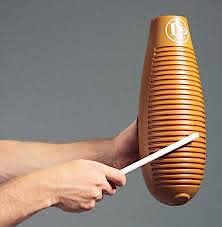
FOOD
WRITING 101: TRY NOT TO USE WORDS
ONLY
ONE OUT OF 1,000 READERS WILL KNOW
“From the shrubbery comes a sound
like a güiro being scraped by an unmusical child in a
school assembly. Then Quammen struts forward, with
brilliant patches of deep blue on his body and a huge
red beak primed to cut like weaponised garden
secateurs.”—David Whitley, “Meet the Natives,” National
Geographic Traveller (June 2015).
Any of John Mariani's books below may be ordered from amazon.com.
 I'm proud and happy to announce that my
new book, The Hound
in Heaven (21st Century Lion Books), has just
been published through Amazon and Kindle.
I'm proud and happy to announce that my
new book, The Hound
in Heaven (21st Century Lion Books), has just
been published through Amazon and Kindle. It is a novella, and for anyone who loves dogs, Christmas, romance, inspiration, even the supernatural, I hope you'll find this to be a treasured favorite. The story concerns how, after a New England teacher, his wife and their two daughters adopt a stray puppy found in their barn in northern Maine, their lives seem full of promise. But when tragedy strikes, their wonderful dog Lazarus and the spirit of Christmas are the only things that may bring back his master back from the edge of despair.
WATCH THE VIDEO!
“What a huge surprise turn this story took! I was completely stunned! I truly enjoyed this book and its message.” – Actress Ali MacGraw
“He had me at Page One. The amount of heart, human insight, soul searching, and deft literary strength that John Mariani pours into this airtight novella is vertigo-inducing. Perhaps ‘wow’ would be the best comment.” – James Dalessandro, author of Bohemian Heart and 1906.
“John Mariani’s Hound in Heaven starts with a well-painted portrayal of an American family, along with the requisite dog. A surprise event flips the action of the novel and captures us for a voyage leading to a hopeful and heart-warming message. A page turning, one sitting read, it’s the perfect antidote for the winter and promotion of holiday celebration.” – Ann Pearlman, author of The Christmas Cookie Club and A Gift for my Sister.
“John Mariani’s concise, achingly beautiful novella pulls a literary rabbit out of a hat – a mash-up of the cosmic and the intimate, the tragic and the heart-warming – a Christmas tale for all ages, and all faiths. Read it to your children, read it to yourself… but read it. Early and often. Highly recommended.” – Jay Bonansinga, New York Times bestselling author of Pinkerton’s War, The Sinking of The Eastland, and The Walking Dead: The Road To Woodbury.
“Amazing things happen when you open your heart to an animal. The Hound in Heaven delivers a powerful story of healing that is forged in the spiritual relationship between a man and his best friend. The book brings a message of hope that can enrich our images of family, love, and loss.” – Dr. Barbara Royal, author of The Royal Treatment.
 |
The Encyclopedia of American Food and Drink by John F. Mariani (Bloomsbury USA, $35) Modesty forbids me to praise my own new book, but let me proudly say that it is an extensive revision of the 4th edition that appeared more than a decade ago, before locavores, molecular cuisine, modernist cuisine, the Food Network and so much more, now included. Word origins have been completely updated, as have per capita consumption and production stats. Most important, for the first time since publication in the 1980s, the book includes more than 100 biographies of Americans who have changed the way we cook, eat and drink -- from Fannie Farmer and Julia Child to Robert Mondavi and Thomas Keller. "This book is amazing! It has entries for everything from `abalone' to `zwieback,' plus more than 500 recipes for classic American dishes and drinks."--Devra First, The Boston Globe. "Much needed in any kitchen library."--Bon Appetit. |
"Eating Italian will never be the same after reading John Mariani's entertaining and savory gastronomical history of the cuisine of Italy and how it won over appetites worldwide. . . . This book is such a tasteful narrative that it will literally make you hungry for Italian food and arouse your appetite for gastronomical history."--Don Oldenburg, USA Today. "Italian
restaurants--some good, some glitzy--far
outnumber their French rivals. Many of
these establishments are zestfully described
in How Italian Food Conquered the World, an
entertaining and fact-filled chronicle by
food-and-wine correspondent John F.
Mariani."--Aram Bakshian Jr., Wall Street
Journal.
"Equal parts
history, sociology, gastronomy, and just
plain fun, How Italian Food Conquered the
World tells the captivating and delicious
story of the (let's face it) everybody's
favorite cuisine with clarity, verve and
more than one surprise."--Colman Andrews,
editorial director of The Daily
Meal.com. "A fantastic and fascinating
read, covering everything from the influence
of Venice's spice trade to the impact of
Italian immigrants in America and the
evolution of alta cucina. This book will
serve as a terrific resource to anyone
interested in the real story of Italian
food."--Mary Ann Esposito, host of PBS-TV's
Ciao
Italia. "John Mariani has written the
definitive history of how Italians won their
way into our hearts, minds, and
stomachs. It's a story of pleasure over
pomp and taste over technique."--Danny Meyer,
owner of NYC restaurants Union Square
Cafe, The Modern, and Maialino.
|
 |
 |
 |
 |
 |
 |
 |
 |
 Everett Potter's Travel Report:
Everett Potter's Travel Report: 
 Eating Las Vegas
is the new on-line site for Virtual Gourmet
contributor John A. Curtas., who since 1995
has been commenting on the Las Vegas food
scene and reviewing restaurants for Nevada
Public Radio. He is also the
restaurant critic for KLAS TV, Channel 8 in
Las Vegas, and his past reviews can be
accessed at KNPR.org.
Click on the logo below to go directly to
his site.
Eating Las Vegas
is the new on-line site for Virtual Gourmet
contributor John A. Curtas., who since 1995
has been commenting on the Las Vegas food
scene and reviewing restaurants for Nevada
Public Radio. He is also the
restaurant critic for KLAS TV, Channel 8 in
Las Vegas, and his past reviews can be
accessed at KNPR.org.
Click on the logo below to go directly to
his site.

Tennis Resorts Online: A Critical Guide to the World's Best Tennis Resorts and Tennis Camps, published by ROGER COX, who has spent more than two decades writing about tennis travel, including a 17-year stretch for Tennis magazine. He has also written for Arthur Frommer's Budget Travel, New York Magazine, Travel & Leisure, Esquire, Money, USTA Magazine, Men's Journal, and The Robb Report. He has authored two books-The World's Best Tennis Vacations (Stephen Greene Press/Viking Penguin, 1990) and The Best Places to Stay in the Rockies (Houghton Mifflin, 1992 & 1994), and the Melbourne (Australia) chapter to the Wall Street Journal Business Guide to Cities of the Pacific Rim (Fodor's Travel Guides, 1991).


MARIANI'S VIRTUAL GOURMET
NEWSLETTER is published weekly. Editor/Publisher: John
Mariani.
Editor: Walter Bagley. Contributing Writers: Christopher Mariani,
Robert Mariani, Misha
Mariani,
John A. Curtas, Edward Brivio, Mort Hochstein,
Andrew Chalk, Dotty Griffith and Brian Freedman. Contributing
Photographers: Galina Dargery, Bobby
Pirillo. Technical Advisor: Gerry McLoughlin.
To un-subscribe from this newsletter,click here.
© copyright John Mariani 2015
